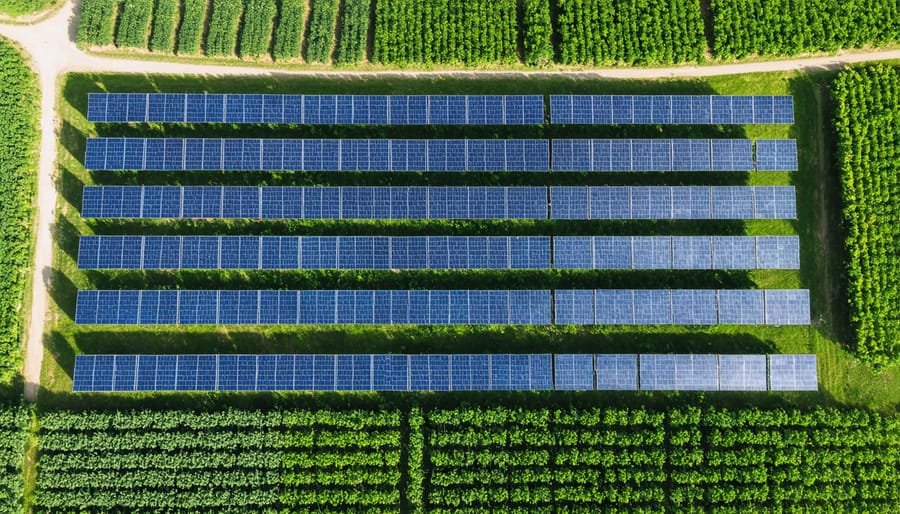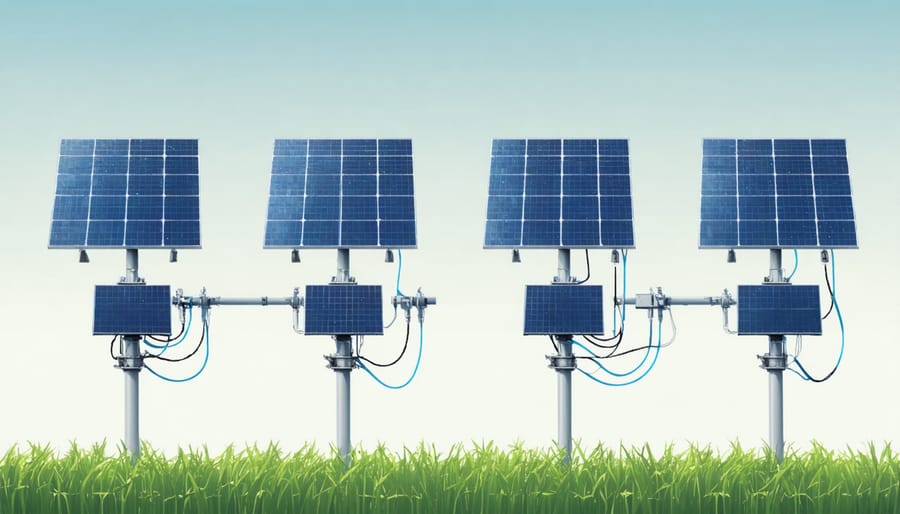The integration of solar energy into agricultural operations represents a transformative shift in modern farming, offering a powerful solution to two critical challenges: sustainable food production and clean energy generation. Farmers who strategically deploy solar installations can reduce carbon emissions while maintaining or enhancing crop yields through agrivoltaic systems. This dual-use approach optimizes land utilization, generating up to 70% more combined value per acre compared to traditional farming or solar installations alone.
Advanced solar technologies now enable agricultural operations to decrease operational costs by 40-60% while creating new revenue streams through energy sales to the grid. Forward-thinking farm operators are leveraging these systems to protect crops from extreme weather events, conserve water through reduced evaporation, and enhance soil moisture retention – critical advantages in an era of climate uncertainty.
For agricultural businesses seeking competitive advantages in today’s market, solar integration represents not just an environmental choice, but a strategic business decision that delivers measurable returns on investment while ensuring long-term operational resilience.
The Rise of Agrivoltaic Systems

Dual-Use Land Benefits
Agrivoltaics represents a revolutionary approach to land management, enabling farmers to double your land’s profit through strategic integration of solar panels and agricultural activities. This dual-use strategy optimizes land utilization by creating two revenue streams from the same acreage: energy generation and crop production.
Research indicates that certain crops actually benefit from the partial shade provided by solar panels. Leafy greens, root vegetables, and berries have shown increased yields when grown under solar arrays, as the panels create a microclimate that reduces water evaporation and protects plants from extreme weather conditions. Additionally, grazing animals like sheep can maintain the grounds beneath solar installations, reducing maintenance costs while providing sustainable livestock operations.
The vertical space optimization achieved through elevated solar panels allows for conventional farming equipment to operate underneath, ensuring minimal disruption to existing agricultural practices. This arrangement typically maintains 70-80% of the original farming capacity while generating clean energy that can power on-site operations or be sold back to the grid.
Modern solar mounting systems are designed to accommodate various agricultural needs, with adjustable panel heights and spacing that can be customized based on specific crop requirements and farming equipment specifications. This flexibility ensures optimal conditions for both energy generation and agricultural productivity, maximizing the return on investment for land owners.
Crop Protection and Climate Control
Solar panels in agricultural settings offer more than just energy generation – they provide crucial protection from extreme weather while creating favorable growing conditions for crops. This dual-purpose approach, known as agrivoltaics, demonstrates remarkable benefits for crop resilience and yield optimization.
The elevated panel structures shield crops from excessive solar radiation, hail, and strong winds, reducing plant stress and water evaporation. During intense heat waves, these installations can lower surface temperatures by 3-6°C, creating a more stable microclimate that benefits temperature-sensitive crops. In regions prone to drought, the shade provided by solar arrays helps maintain soil moisture levels, resulting in water savings of up to 30%.
Studies conducted across various agricultural zones have shown that certain crops, particularly shade-tolerant species, thrive under partial solar coverage. The diffused light created by panel arrangements can enhance photosynthetic efficiency in some plants, leading to improved crop quality and consistency. During cold seasons, the panels act as thermal barriers, helping to maintain warmer soil temperatures and potentially extending growing seasons.
The strategic placement of solar installations also creates wind breaks and can help prevent soil erosion, particularly in areas susceptible to strong weather events. This protective infrastructure has proven especially valuable for high-value crops that require careful environmental management for optimal production.
Financial Advantages for Farmers
Energy Cost Reduction
The integration of solar energy systems in agricultural operations has proven to be a significant cost-reduction strategy for farmers and agribusinesses. Studies show that agricultural facilities implementing solar power systems typically reduce their energy expenses by 40-75% within the first year of installation, depending on the system size and local utility rates.
A notable example is the Anderson Family Farm in California, which reduced its annual energy costs from $24,000 to $6,800 after installing a 50kW solar array to power their irrigation systems and cold storage facilities. The initial investment was recovered within four years through energy savings and available tax incentives.
Solar-powered irrigation systems particularly demonstrate substantial cost benefits, eliminating fuel costs associated with traditional diesel pumps. Farms utilizing solar-powered water pumping systems report average annual savings of $3,000 to $8,000 per pump installation, while also reducing maintenance expenses by up to 60%.
The cost advantages extend beyond direct energy savings. Many agricultural operations qualify for federal and state incentives, including the Rural Energy for America Program (REAP), which can cover up to 25% of installation costs. Additionally, net metering agreements with utility companies allow farmers to sell excess power back to the grid, creating a new revenue stream during low-consumption periods.
Modern solar installations also come with smart monitoring systems that help optimize energy usage patterns, leading to further operational cost reductions and improved energy efficiency across farming activities.

Additional Revenue Streams
Integrating solar energy into agricultural operations opens multiple revenue streams beyond traditional farming income. Power generation through solar installations can create significant financial benefits through net metering arrangements with utility companies. Farmers can sell excess electricity back to the grid during peak production periods, creating a steady income stream throughout the year.
Government incentives and tax benefits further enhance the financial appeal of agrivoltaic systems. Federal programs like the Rural Energy for America Program (REAP) offer grants covering up to 25% of project costs and loan guarantees for renewable energy systems. State-level incentives, including Solar Renewable Energy Credits (SRECs) and property tax exemptions, provide additional financial support.
Many agricultural operations are also benefiting from community solar partnerships, where local businesses and residents can purchase solar credits, creating a reliable revenue stream while supporting renewable energy adoption in the community.
Carbon credit markets represent another emerging opportunity, as solar-powered farms can qualify for carbon offset programs. These credits can be sold to companies seeking to reduce their carbon footprint, providing an additional income source while contributing to environmental sustainability.
Agricultural businesses can also leverage their solar installations for educational tourism and demonstration projects, creating supplementary income through facility tours and educational programs for schools and environmental organizations.
Implementation Strategies
System Design Considerations
When designing solar installations for agricultural settings, several critical factors must be considered to ensure optimal performance and minimal impact on farming operations. The physical layout should account for crop rotation patterns, equipment access routes, and seasonal sun exposure variations. Most successful agrivoltaic systems incorporate elevated panel mounting systems, typically 8-12 feet high, allowing farm machinery to operate underneath while maintaining adequate light distribution for crops.
Water management integration is essential, with careful consideration given to drainage patterns and irrigation systems. Solar panel arrangements should complement existing irrigation infrastructure and include measures to handle water runoff from panels effectively. This often involves strategic placement of water collection systems and the implementation of permeable ground covers.
Space optimization requires careful analysis of land use efficiency. Modern bifacial solar panels can increase energy yield while reducing the overall footprint, making them particularly suitable for agricultural applications. The structural support system must be engineered to withstand local weather conditions while minimizing soil disturbance and maintaining soil health.
Electrical infrastructure planning should account for both current and future power needs. This includes properly sized inverters, appropriate cable routing that doesn’t interfere with farming activities, and strategic placement of electrical equipment to protect it from agricultural operations and weather exposure. Additionally, monitoring systems should be integrated to track both energy production and environmental conditions affecting crop growth.

Choosing the Right Technology
Selecting the appropriate solar technology for your agricultural operation requires careful consideration of several key factors. First, assess your farm’s energy requirements by conducting a comprehensive energy audit. This will help determine whether you need a grid-tied system for supplementary power or a standalone system for remote operations.
For greenhouse operations, semi-transparent photovoltaic panels offer dual benefits of power generation and controlled shading. These systems typically achieve 20-30% transparency while maintaining optimal growing conditions. In contrast, open-field farming may benefit more from elevated solar arrays that enable continued crop cultivation underneath, known as agrivoltaic systems.
Water pumping applications require specific solar solutions. DC-powered pumps are often more efficient for irrigation systems, while AC pumps might be better suited for larger operations with existing electrical infrastructure. Consider the seasonal variation in water needs when sizing these systems.
Storage solutions also play a crucial role. While battery systems provide reliability during non-sunlight hours, they represent a significant investment. For farms with predictable daytime energy needs, direct-use systems might be more cost-effective.
When evaluating vendors, prioritize those with agricultural experience and proven track records. Look for warranties that align with agricultural operational timeframes, typically 20-25 years for panels. Also, ensure the selected technology can withstand local weather conditions and integrate with existing farm management systems.
The integration of solar technology in agriculture represents a pivotal shift toward sustainable and profitable farming practices. By embracing solar solutions, agricultural businesses can significantly reduce operational costs while contributing to environmental conservation. The dual benefits of energy independence and increased crop yields make solar adoption a strategic imperative for forward-thinking farm operations. As climate challenges and energy costs continue to rise, agricultural businesses that implement solar technologies position themselves for long-term success and resilience. Now is the time for farm owners and agricultural managers to evaluate their solar potential and take decisive action. By partnering with experienced solar providers and utilizing available incentives, agricultural operations can transform their energy infrastructure while maintaining competitive advantage in an evolving market. The future of farming is sustainable, efficient, and solar-powered – making today’s investments the foundation for tomorrow’s agricultural success.

